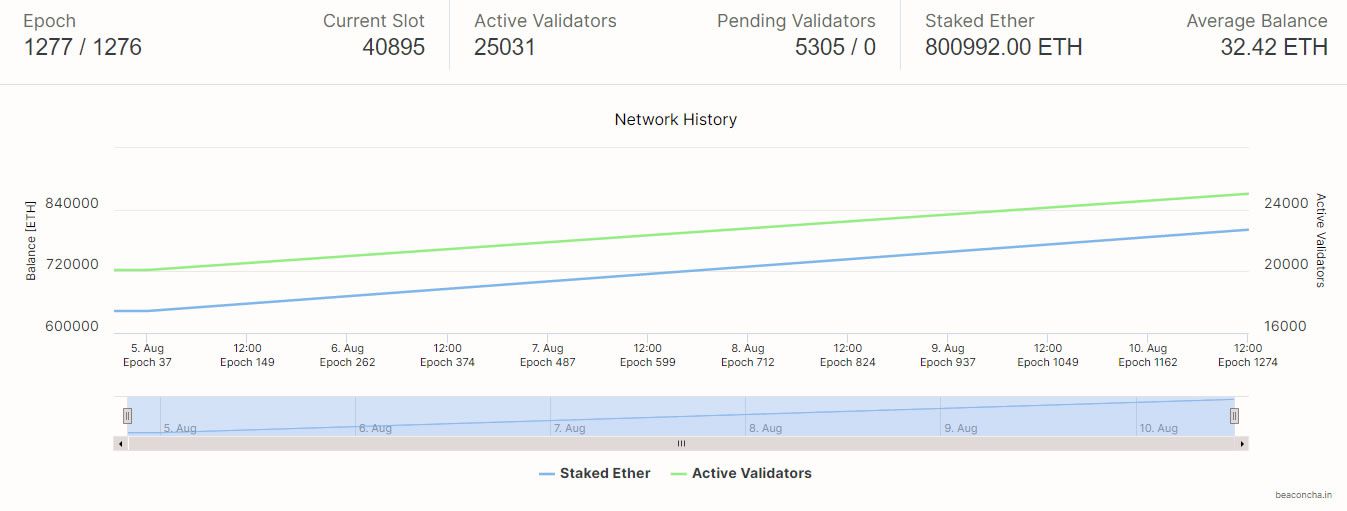It’s been almost a week since the launch of the ETH 2.0 final public testnet, which has been performing as intended by most accounts. As many as one million ETH have been staked on the Beacon Chain simulation, reviving hopes of a mainnet launch later this year.
The Medalla ETH 2.0 testnet has been running for six days which has given developers a chance to monitor early progress. Launched on Aug 4, Medalla is the fifth and final testnet for the long-awaited upgrade to an Ethereum proof-of-stake consensus.
Phase 0 testing began in April with the first Topaz testnet. Since then the staking levels, validator count, and the number of clients have increased on the network. Medalla represents the closest thing to a final simulation of Beacon Chain.
According to the official Medalla Launchpad, over one million GöETH (simulated ETH for the Göerli testnet) have been staked.
Ethereum protocol developer, Terence Tsao [@terencechain], acknowledged the achievement:
Woo! Medalla deposit contract just exceeded over 1M GöEth! #eth2 pic.twitter.com/DXI3qlHodm
— Terence Tsao (@terencechain) August 9, 2020
However, the Beacon Chain tracker reports a lower figure of around 800,000 GöETH staked at the time of press. There are slightly fewer than 25,000 validators with nearly 5,000 more pending according to the tracker.

No actual Ethereum is used in the testing as it is purely a simulation, meaning that no real staking rewards have been paid out yet. Since the launch, there have been approximately 582 GöETH earned by validators.
Medalla Making Progress
ConsenSys researcher, Ben Eddington, has posted an update to last week’s events.
He stated that the launch itself was a little anticlimactic. Initial participation by validators was low, taking around 7 epochs, or approximately 40 minutes before the chain first finalized.
Eddington added that it was not that big a deal but may need to be addressed for the real launch:
To improve some of these issues for the Mainnet launch, we’re looking at increasing the genesis delay from its current 48 hours, to 96 hours, or even a week. This buffer will allow everyone to get their ducks in a row.
The researcher confirmed that everything has been running well since the launch and client teams have issued updates to address various issues. The write-up also includes a number of guides on how to set up your own ETH 2.0 testnet node.

Attacknets, which welcome hacks and exploits in order to search for vulnerabilities are a big part of the testing process. A nine-year-old bug in one of the Prysm clients was already discovered by one hacker and rewards of up to $15,000 are up for grabs for those that manage to successfully exploit the code.
Prysmatic Labs, which provides one of the most popular ETH 2.0 clients, also published its own summary of the week’s events.
It spent a lot of time and effort updating wallets and the client software for compatibility and interoperability. Prysm supports three different kinds of wallets, a remote server sign-in wallet, a non-HD wallet where accounts are password protected and imported from an external source, and an HD wallet which is generated from a mnemonic phrase enabling new accounts to be created deterministically.
Naturally, there were a few synchronization bugs to be ironed out and the client software developers highlighted them in the report. It added that a graphical user interface has been one of the most requested features from ETH 2.0 validators and one is in the pipeline:
Our goal is to have a password-protected local interface you can use to manage your validator accounts, view your validator’s performance, and look at process analytics as needed.
ETH 2.0 Client Diversity Issues
Prysmatic Labs are clearly proud that its client is the most popular, but it does lead to a diversity issue.
According to Ethernodes.org, the Prysm client accounts for 66% of the total, with just under 24% using Lighthouse, and the remainder working with the other participating clients.

Breaking down the validators geographically revealed that 31.1% of active network peers are located in the U.S., with second place going to Germany at 21.7%, and the UK coming in third at 5.6%.
There was very little participation from Asian nations, with only a few percent being split across Singapore, South Korea, Japan, and China.
Ideally, client diversity needs to be expanded before a full launch.

Due to the U.S. being dominant in the testing phase, it was no surprise that looking at a plot revealing network reliance on ISPs and cloud providers, Amazon Inc. providers dominated.
ETH Price Update
Ethereum prices have briefly tapped the psychological $400 barrier again a handful of times over the weekend but failed to close over the level.
At the time of press, ETH was building on the momentum from a Sunday swing-low and is trading hands at $396.

So far this month, Ethereum has managed to hold on to its gains and is still up 66% since the same time last month. A fall back to those levels is highly unlikely, however, a short-term pullback has been anticipated.
On-chain metrics, on the other hand, suggest that Ethereum is still undervalued.
The recent Medalla-induced momentum has been a long time coming for ETH holders but its price action going forward is likely to be a product of Bitcoin’s movements. With BTC just registering its highest weekly close in two-and-a-half years, the bulls are definitely ready to run, and this will likely only benefit Ethereum even further.
The post Ethereum 2.0 Testnet Performing Well, 1 Million ‘ETH’ Staked appeared first on BeInCrypto.
